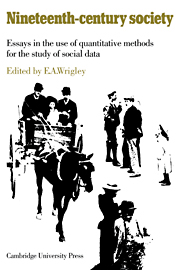Book contents
- Frontmatter
- Contributors
- Contents
- Introduction
- 1 The census, 1801–1891
- 2 The study of family structure
- 3 Sources of inaccuracy in the 1851 and 1861 censuses
- 4 Standard tabulation procedures for the census enumerators' books 1851–1891
- 5 Sampling in historical research
- 6 The use of information about occupation
- 7 The use of published census data in migration studies
- 8 Criminal statistics and their interpretation
- 9 The incidence of education in mid-century
- Notes
- Bibliography
- Index
4 - Standard tabulation procedures for the census enumerators' books 1851–1891
Published online by Cambridge University Press: 05 November 2011
- Frontmatter
- Contributors
- Contents
- Introduction
- 1 The census, 1801–1891
- 2 The study of family structure
- 3 Sources of inaccuracy in the 1851 and 1861 censuses
- 4 Standard tabulation procedures for the census enumerators' books 1851–1891
- 5 Sampling in historical research
- 6 The use of information about occupation
- 7 The use of published census data in migration studies
- 8 Criminal statistics and their interpretation
- 9 The incidence of education in mid-century
- Notes
- Bibliography
- Index
Summary
Sociologists and social historians use the census enumerators' books for many different purposes. Quite frequently they simply want to amplify information obtained from the published reports on the number of persons in certain categories (numbers of migrants, miners, or married women, for example) in a community. In particular, it is often necessary to obtain information of this kind for areas different from (and usually smaller than) those for which details are published in the reports. Often, however, obtaining such information is only a beginning, for the enumerators' books suitably analysed can reveal very much more than simple counts of numbers in categories. The investigator may be interested in locating non-random regularities in the frequency with which persons in one category are also members of specified other categories (the proportion of lodgers who are also bachelor migrants, for example). Or he may be seeking information about the distribution in the population under study of patterns of group membership (the proportion of houses containing different numbers of persons, or the proportion of ‘households’ containing kin, lodgers, or servants). Or, finally, he may be interested in investigating the frequency with which persons who are members of both of a pair of categories (e.g. head of household and migrant) are found as members of the same group (e.g. household) as persons who are members of the same or other pairs of categories (e.g. lodger and migrant).
- Type
- Chapter
- Information
- Nineteenth Century Society , pp. 134 - 145Publisher: Cambridge University PressPrint publication year: 1972
- 3
- Cited by



